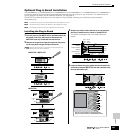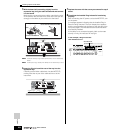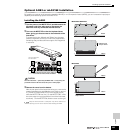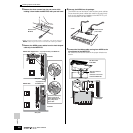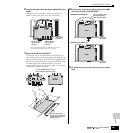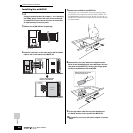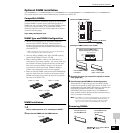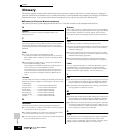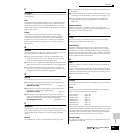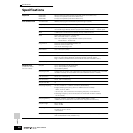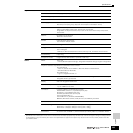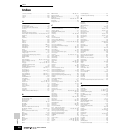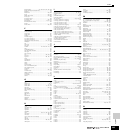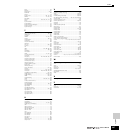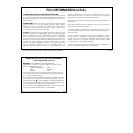
Glossary
291
Owner’s Manual
Appendix
P
Parameter
A setting or data item which you can edit in the various mode and sub
mode displays.
Part
This refers to sound producing sections in the tone generator block
that make up a Song, Pattern or Performance. In the Performance
mode, all four Parts are set to the same MIDI channel; in the Song/
Pattern mode, each Part can be independently assigned to a spceifc
MIDI receive channel.
Preset
This refers to pre-programmed data supplied with the internal
memory of the instrument as shipped from the factory. There are
various types of Preset data, such as Preset Voices and Preset
Phrases. The other type of data, User, is for data you’ve created or
edited on the instrument (or computer), such as User Voices and
User Phrases.
Q
Quantize
A function that lets you “clean up” or “tighten” the timing of notes. The
MOTIF ES provides three different Quantize functions:
[1] One of the Jobs provided in the Song Job mode/Pattern Job
mode, which lets you “clean up” or “tighten” the timing of notes
you’ve recorded in Realtime recording (page 227).
[2] A function in the Song Record mode/Pattern Record mode, which
aligns the timing of notes automatically as you record (page 222).
[3] A parameter that determines the timing (such as measure, 1/2
note, and 1/4 note) by which the pattern actually switches when
changing a pattern during playback (page 262).
R
Record
On the MOTIF ES, this term refers to the following operations.
[1] Recording of your musical performance using the keyboard or
controllers to a Song track as MIDI events.
Song Record mode ....................................................page 118
[2] Recording of your musical performance using the keyboard or
controllers to a Pattern track as MIDI events.
Pattern Record mode .................................................page 110
[3] Recording the audio signal from a microphone or an external
audio source (played back via the audio equipment such as a CD
player) to the internal memory as a Sample (Audio data).
Sampling Record mode ................................pages 94 and 107
S
Sequencer
An instrument or function that records, edits, modifies, and plays
back a musical performance in the form of MIDI messages. You can
use the MOTIF ES as a sequencer in the Song mode and Pattern
mode.
Source
On the MOTIF ES, “source” has three different meanings or uses:
[1] In copy operations, this refers to the original file or data which is to
be copied.
[2] In sampling operations, this refers to external audio which is to be
recorded (to the internal memory “destination” area) (page 172).
[3] In the Controller Set function, this refers to the controller that is
assigned to adjust a particular parameter (the “destination”)
(page 155).
Synchronization
Refers to the function or process of “locking” the timing of two
devices (for example, two sequencers connected via MIDI), using the
timing clock of one to control the other.
T
Track
A memory location on the sequencer where musical performance
(MIDI event) and audio data is recorded.
Tune/Tuning
A process of matching the pitch of two or more instruments when
playing in an ensemble. Normally, A3 is tuned to 440 Hz. There are
two types of tune: Coarse Tune that adjusts the tuning in semitones
and Fine Tune that adjusts the tuning in cents. In addition, the MOTIF
ES has a Voice parameter (Micro Tuning) that lets you set the tuning
of each individual note of the keyboard.
U
User
Refers to the data you create via various functions on the MOTIF ES
(or computer).
There are various types of User data, such as User Voices and User
Phrases. The other type of data, Preset, refers to data that has been
created or pre-programmed for the instrument at the factory, such as
Preset Voices and Preset Phrases.
V
Velocity
A parameter within the MIDI Note On message that conveys the force
of the note.
Voice
A musical instrument sound built into the MOTIF ES. The following
types of Voices are available on the instrument.
• Normal Voice ................ page 160
• Drum Voice................... page 160
• Plug-in Voice................. page 76
• Board Voice .................. page 76
• Mixing Voice ................. page 105
• Sample Voice................ page 173
• Phrase Voice................. page 167
Voice data that is supplied with the internal memory of the instruments
shipped from the factory is referred to as a “Preset Voice.” Voice data
you create or edit via the Voice Edit or the Sampling function, using
the preset waves supplied with the instrument or the wave obtained
via the Sampling function is referred to as a “User Voice.”
Volume Label
This refers to the name you can assign to storage devices such as a
SmartMedia and hard disk.



